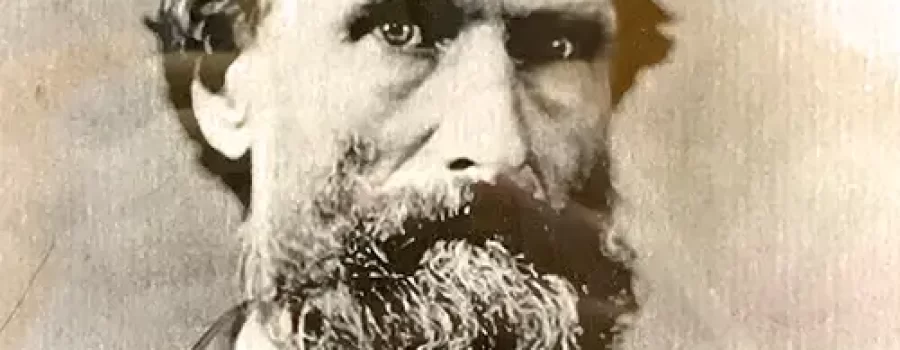
You will see this photo on the wall at the Silver Reef Museum. Here are 10 fun facts about Joseph Ellis Johnson.
- Called to settle St. George in 1865
- Built first library in St. George
- Built first drug store in St. George
- Built a boarding house, store and printing office in Silver Reef.
- Published first edition of the Silver Reef Echo on Feb 24, 1877.
- Was the number one horticulturist in souther utah winning awards from the Dereret Agricultural & Manufacturing society for the “best fenced garden in Utah” (1872) and the “best collection of medicinal herbs” (1879)
- First bee-keeper in southern Utah.
- Discovered four unreported plants for the U.S. Department of Agriculture, three of which are named for him. (see photos)
- Brought in many plant species to southern Utah that are all around today.
- Was a polygamist and had 27 children.
Joseph Ellis Johnson built a boarding house, store and printing office in Silver Reef in 1876. There he pulished the first and only edition of the Silver Reef Echo on February 24, 1877.
Joseph had been called to settle in “Warm Valley,” as the Rio Virgin country was called in the earlier days, by the Church of Jesus Christ of Latter Day Saints. He started the first library, drug store, and brought many of the plants and tree species into the area that are still here today. He was an avid horticulturist and was excited to test out his planting skills in the warmer climate.
Here are a couple exerpts about Joseph from a 1949 article that appeared in the January 1949 issue of Daughters of the Utah Pioneers titled “Horticulture in the West”, compiled by Kate B. Carter.
“In 1865…began the develoopment of a garden that was to occupy his attention for nearly twenty years in which was to become one of the show places of southern Utah. Still in the possession of the family are two medals, both made from smooted-off silver dollars, awarded to this garden by the Deseret Agricultural & Manufacturing Society. One in 1872 was inscribed for the “beest fenced garden in Utah,” the other given in 1879 for the “best collection of medicinal herbs.”
“[Joseph] was the first to start bee-keeping and he introduced white clover and other plants into the country as bee food. He was a member of the American Pomological Society and was always in communication with eastern growers and with the Department of Agriculture.”
There are at least four previously unreported plants discovered by Joseph, three of which were named for him.
“Of the three which honored him, one is the thickly spined cactus with a showy pink blossom (the Arizona variety is yellow). It was named Echinocactus johnsoni…but is now called Echinomostus johnsoni.

Desert Beauty, the shrub with brilliant purple, pea-like flowers, which in spring lights up the desert from St. George to California was christened Dalea johnsoni but this has now been changed to Parosela johnsoni.

A showy species of evening primrose found growing in the Beaver Dam mountains was given the name of Oenothera johnsoni but as with the others, later botanists have placed it in another niche as Pachylophus johnsoni.”

Throughout his life, Joseph always left a place better than he found it. From crossing the plains with the pioneers, to Salt Lake, Utah county, St. George, Silver Reef, Kanab, Arizona and into Old Mexico. As you walk by his photo on the wall at the museum, realize that you are looking into the eyes of a man who helped make southern Utah the beautiful place it is today.



![Identifying Chinese Artifacts [Video]](https://silverreef.org/wp-content/uploads/2023/12/Chris-holding-liquor-jar-300x200.webp)

